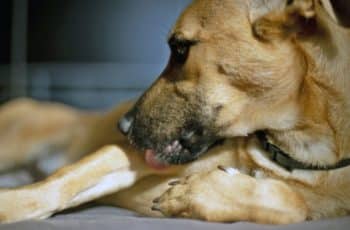The pads on the bottom of your dog’s paws are thick and strong, but they can be injured. The first signs are usually limping and/or licking at a foot. Three common ways dogs injure their pads are:
- Lacerations
- Sores
- Wearing off the thick outer protective layer
Lacerations are when your dog’s pad is cut, such as by broken glass or sharp rocks. If the cut goes all the way through the tough pad and into the softer tissue beneath, it will be painful and likely bleed.
Sores can be caused by minor abrasions, a fungal or bacterial infection, or allergies. Often the first sign is your dog licking at the paw. If an infection is present, there may be an odor or drainage.
Wearing away the pad layer is when your dog “runs off” a pad. This is painful, and your dog may not want to let you touch the paw.
Raw Paw Pads
Prolonged running on a hard surface can separate the pad from the foot. Sometimes the dog’s paw pads are ripped off, leaving just raw tissue beneath, and other times they will only be partially torn with a flap.
Your dog’s paw pad will regrow, but this takes time. Most of these injuries can be managed at home, but if your dog has a deep cut in the pad that is bleeding, she should be seen by a veterinarian. The wound may need to be flushed, and she may need antibiotics to prevent infection. A study of military and pet dogs with paw lacerations found that short-term complications were found in 27% of the dogs.
If the wound isn’t severe, pull out your first-aid pack and begin treatment:
Clean the Wound
Gently flush the wound with water or an antiseptic, such as chlorhexidine. Gently remove debris, like rocks or glass carefully. Don’t use force out anything lodged deep into the foot.
Control Bleeding
Apply pressure with a clean towel to stop bleeding. Use an ice pack to encourage blood-vessel constriction. Deep wounds and punctures can bleed heavily. Uncontrolled bleeding is a veterinary emergency.
Protect the Wound
Many pad injuries benefit from a bandage and/or booties as protection while they heal. A bootie, like the Ruffwear Grip Tex or Canada Pooches Hot Pavement Boots, can help keep the paw protected and clean. (Whole Dog Journal rated both summer and winter boot choices.)
You can use a disposable paw bandage, like the PawFlex MediMitt, or make your own using a nonstick gauze or a Telfa pad secured with paper tape or Vetrap. (Don’t make the bandage too tight, which can restrict circulation! You should be able to slide two fingers under the bandage. If the bandage slips, wrap more tape around the top of the bandage.)
If your dog has burned off a small section of her paw pad, a liquid bandage like Nutri-Vet Liquid Bandage Spray can offer a layer of protection. Apply this with care, though, as it can sting.
Keep the wound and bandage dry to prevent infection. Most paw bandages need to be changed daily. If you’re using a commercial boot, clean and dry it before reapplying.
Allow It to Heal
An injured dog needs rest. Only walk the dog on leash, and limit running and jumping inside as well. Prevent chewing at the bandage, which may require the use of an Elizabethan collar).
Be patient while your dog heals. Even once the pad has sealed over, it can take months for the keratin (outer) layer to return to its normal strength. Use a bootie or other paw protection when going for long walks or running and call it a day if your dog appears sore. You can also apply our homemade salve (see sidebar) to help protect his pads from environmental hazards.
Soothing Dog Paw-Butter
By C.J. Puotinen
Dog-paw butter protects feet in hot and cold weather, soothes cracked or sore paw pads, and blocks winter salt burn. It can also be applied to cracked noses. Save some for yourself and your friends as this is an effective lip balm and a great moisturizing salve for cuticles, hands, and feet.
In a wide-mouth pint-sized glass canning jar combine:
Ingredients:
- 1⁄3 cup olive, sunflower, sweet almond, or jojoba oil
- 1⁄3 cup coconut oil
- 2 tablespoons shea butter or mango butter
- 2 tablespoons beeswax (chopped or beads)
Instructions:
Place the jar in a saucepan containing a cup of water to create a double boiler. Over low heat, gently stir the ingredients with a wooden chopstick until they are fully combined.
Optional: add the contents of a vitamin E oil capsule
Optional: add 10 drops tea tree, lavender, chamomile, or other essential oil
Leave a metal spoon in the freezer while you make the salve. To test its consistency, dip the frozen spoon into the melted blend and apply to your hand. If it’s too stiff, add a little oil; if it’s too liquid, add more beeswax. When it’s just right, pour it into small jars or tins and apply to your dog’s paw pads as needed. (Click here for recipes for homemade shampoo and a rinse.)


